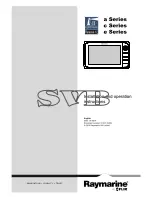
10
“Operation and installation manual”
EN
2.2.1 Risks related to improper use or product defect
Any improper use of the device is forbidden, even for common other arrangement related to the final scope
and function.
To avoid any serious consequence on personal safety, please contact the service of the manufacturer in case
of need of further warnings concerning the ways in which the equipment must not be used and which could
occur.
In the event of residual risks which persist, despite the protection and safety measures integrated in the
machine and the complementary measures adopted, contact the service of the manufacturer immediately.
Do not proceed with installation if the integrity of the equipment is compromised.
Do not use the equipment if you find any operating anomalies.
To avoid risk related to improper use of the product, it is forbbiden:
• To install the equipment in environments subject to particular conditions of flammability or in adverse or
disallowed environmental conditions, (temperature and humidity).
• To use the equipment with safety devices which are faulty or disabled.
• To use the equipment or parts of the equipment by linking it to other machines or equipment, unless
expressly provided for.
• To modify operating parameters that are not accessible to the operator and/or parts of the equipment to
vary its performance or change its isolation.
• To clean with corrosive products that could corrode parts of the equipment or generate electrostatic
charges.
• To place any heavy object, sit or stand up on the device.
2.2.2 Residual risks
Despite the warnings and safety systems, there are still some residual risks that cannot be eliminated.These
risks are listed in the following table with some suggestions to prevent them:
Risk analysis and description
Suggested action
Noise pollution due to installation in unsuitable
environments or where individuals routinely work
and/or animals dwell most of the time.
Reassess the environment or the place of
installation.
Adverse external climatic conditions, accumulations
of rainwater, low temperatures, high humidity, etc.
Maintain ambient conditions suitable for the system.
Overheating of components (transformers,
accumulators, coils, etc.) which could cause burns.
Clogged equipment cooling slots or systems.
Use suitable PPE. Wait for the parts to cool down
before opening the equipment.
Do not block cooling vents or heat sinks.
Inadequate cleaning that:
- does not allow adequate air intake for cooling
- does not allows the reading of safety labels.
Clean the equipment, labels and installation
environment.
Stored energy in components that could generate
hazardous discharges.
Ensure that the components have discharged their
energy before working on them.
The EVSE contains components and circuit boards
that are sensitive to electrostatic discharge.
Take ESD prevention measures to protect the
electronic components during installation and
maintenance of the EVSE.
Inadequate training of staff.
Ask for supplementary courses.
Incomplete installation, equipment or its
components temporarily mounted.
Prevent unauthorized access to the installation area.
Use a sufficient number employees and PPE.
No cable extensions, adapters, Y-cables or similar
may be used unless explicitly stated by the vehicle
manufacturer.
Manufacturer and national guidelines and
regulations about charging stations must be taken
into account.
The AC cable, owned by the user, could be damaged Check the integrity of the cable and connectors
before connecting the cable to the EVSE.
Not allowed to place in ATEX environment.
Reassess the environment or the place of
installation.











































